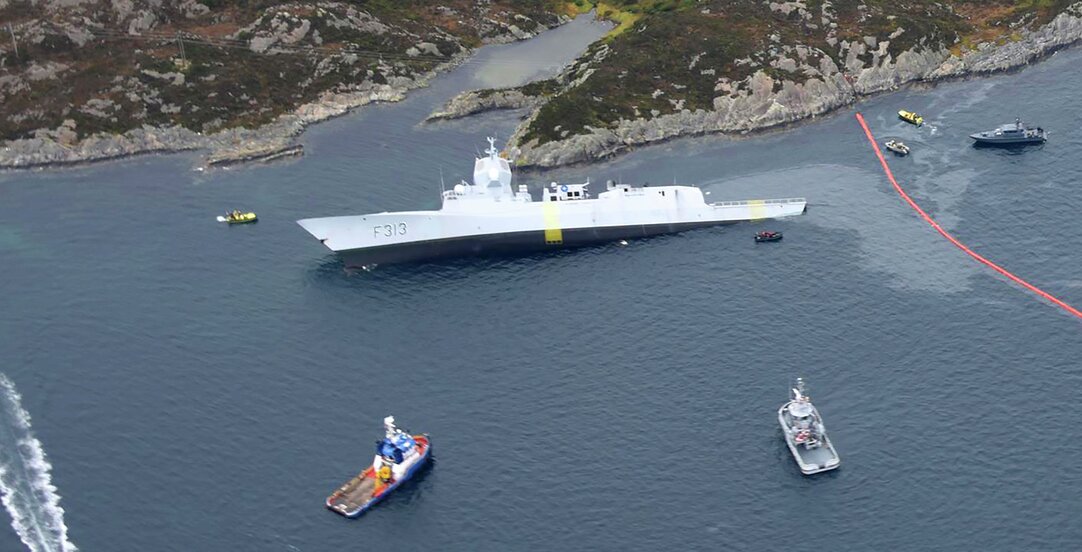Limitation of liability for collisions claims in respect of wreck removal expenses

A recent decision in the Norwegian proceedings relating to the collision between the Norwegian navy frigate “Helge Ingstad” and the oil tanker “Sola TS” saw Hordaland District Court weigh in on a question that has been the subject of international debate for some time. The court held that the Norwegian state’s indemnity claim against the owners of the “TS Sola” in respect of the costs of the removal of the wreck of the “Helge Ingstad” is subject to the limitation amount for claims in respect of property damage and not the separate and higher limitation amount for claims in respect of clean-up and wreck removal.
As a result of the collision in the Hjeltefjorden on the West Coast of Norway on 8 November 2018, “Helge Ingstad” sank and was later deemed a total loss. Fortunately, there were no lives lost. The state commenced proceedings before Hordaland District Court, where it brought claims against the owners of the “Sola TS”, Twitt Navigation Limited (“Twitt”), in the amount of about NOK 13 billion for the total loss of the frigate and about NOK 770 million for the costs of the wreck removal. Twitt established a limitation fund before the same court for claims in respect of property damage in accordance with the Norwegian Maritime Code (“NMC”) section 172, ref. section 175 No. 3. Apportionment of liability for the collision is disputed and is not yet determined in the proceedings.
While the parties agreed that the total loss claim was subject to the limitation amount for property damage the issue in dispute between the parties was whether the state’s claim for the wreck removal costs was also subject to the same limitation amount. Twitt argued that it was. The state however contended that the claim for the wreck removal costs was instead subject to the separate and higher limitation limit for claims in respect of clean-up and wreck removal under sections 172a and 175a of the NMC.
Based on the gross tonnage of the “Sola TS” the limitation amount for property claims was NOK 400 million, whereas the limitation amount for clean-up and wreck removal claims was significantly higher at NOK 1,150 million. It follows that, if the wreck removal claims were subject to the limitation amount for clean-up and wreck removal claims, such claims would not in fact be limited. On the other hand, if the same claims were subject to the limitation amount for property claims, they would be limited and compete with the total loss claim.
LLMC and Norwegian law
Norway is party to the Convention on Limitation of Liability for Maritime Claims 1976 (“LLMC”) as amended by the 1996 Protocol. The LLMC Article 2 sets out which claims can be limited by the shipowner. Article 2(1) distinguishes on the one hand between “claims in respect of […] loss of or damage to property […] in direct connexion with the operation of the ship […] and consequential loss resulting therefrom” in paragraph (a) and on the other “claims in respect of the raising, removal, […] of a ship which is sunk, wrecked, stranded or abandoned, including anything that is or has been on board such ship” in paragraph (d). Article 2 provides that this distinction applies even where the relevant claims are “brought by way of recourse or for indemnity under a contract or otherwise”.
Norway, similarly to many other countries, has reserved the right under LLMC Article 18 to exclude claims in respect of clean-up and wreck removal in Article 2(1)(d) and (e) from the application of the LLMC. For such claims Norway has instead implemented a separate and higher limitation limit in NMC section 172a and 175a.
The court’s decision
In its decision on 16 November 2021, Hordaland District Court recognised that there is a certain overlap between consequential loss arising from property damage in paragraph (a) and claims in respect of clean-up and wreck removal in paragraph (d) and that, when read in isolation, the wording allows for the state’s claim in respect of the wreck removal to fall within both paragraphs (a) and (d).
However, there were three decisive factors which lead he Court to the conclusion that the state's claim in respect of the wreck removal fell within Article 2(1)(a), and was therefore subject to the limitation amount for property claims.
First, the Norwegian preparatory works prior to the decision of implementing the reservation against LLMC Article 2(1)(d) and (e) provide that a strong motive was to prevent the public authorities from footing the bill for the clean-up expenses, which suggests that the reservation was not intended to apply to collision claims between two ships.
Secondly, the intention behind the reservation against Article 2(1)(d) and (e) was not to confine the application of Article 2(1)(a).
Thirdly, the court emphasised that the NMC sections 172 and 172a should not be construed in a way that is contrary to Norway’s international obligations as a member of the LLMC.
Concluding remarks
The question as to whether collision claims against another ship for wreck removal costs shall be construed as either being claims for consequential losses arising from property damage and thus subject to the LLMC Article 2(1)(a) or claims in respect of wreck removal subject to the LLMC Article 2(1)(d) is a difficult one. There are arguments of merit in favour of both positions and no uniform interpretation across the LLMC member states. It is anticipated that the Hordaland District Court will not have the last say on this issue.
